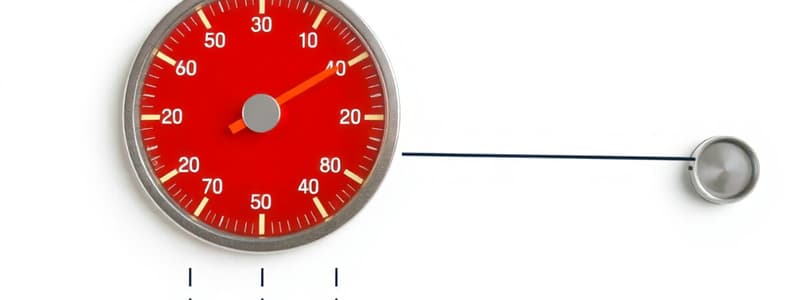Podcast
Questions and Answers
Which factor primarily influences the selection of a specific behavioral measurement technique?
Which factor primarily influences the selection of a specific behavioral measurement technique?
- The researcher's personal preference for a particular method.
- The nature and characteristics of the behavior being studied. (correct)
- The availability of sophisticated technological equipment.
- The ease and convenience of data collection and analysis.
What is the key goal when researchers strive to improve the validity of a behavioral measure?
What is the key goal when researchers strive to improve the validity of a behavioral measure?
- To enhance people willingness to participate in the study.
- To minimize the effort and resources required to collect the data.
- To ensure the measure accurately reflects the behavior it’s intended to assess. (correct)
- To increase the consistency and stability of the measure over time.
How does increasing the number of observations or measurement trials typically affect the reliability of behavioral measures?
How does increasing the number of observations or measurement trials typically affect the reliability of behavioral measures?
- It makes data analysis more complex and therefore the reliability is compromised.
- It has no impact on reliability as it depends solely on the instrument used.
- It decreases reliability due to participant fatigue.
- It generally increases reliability by reducing the impact of random errors. (correct)
A researcher is developing a coding system for observational data. What primary concern should guide their decisions during this process?
A researcher is developing a coding system for observational data. What primary concern should guide their decisions during this process?
What distinguishes inter-observer reliability from test-retest reliability in behavioral measurement?
What distinguishes inter-observer reliability from test-retest reliability in behavioral measurement?
Flashcards
Behavior Measurement
Behavior Measurement
The process of collecting data on how organisms act in various conditions.
Quality of Measurement
Quality of Measurement
The degree to which a measurement accurately reflects the behavior it intends to measure.
Observable Behavior
Observable Behavior
Any behavior that can be seen and recorded during measurement processes.
Assessment Techniques
Assessment Techniques
Signup and view all the flashcards
Data Collection Methods
Data Collection Methods
Signup and view all the flashcards
Study Notes
Chapter 4: Measuring Behavior
- Artifact: A phenomenon appearing to exist due to how it's measured.
- Celeration: Measures how response rates change over time; expressed as a factor. It shows the acceleration or deceleration of responding. This is displayed on a Standard Celeration Chart.
- Count: The number of responses per unit of time. Used to calculate rate, celeration, percentage, and trials to criterion. Simply tally the observed responses.
- Discrete Trial: An operant whose response rate is controlled by a specific opportunity to respond. Each response occurs when the opportunity to respond exists.
- Duration: The time from the start to the end of a response; total duration measures cumulative time a person engages in a behavior. Duration per occurrence measures the duration of each event, and is often reported by mean or median, including the range of durations in each session. Duration is useful for behaviors problematic due to too long or too short durations.
- Event Recording: Records the number of times a behavior occurs. Useful for behaviors that occur at high rates and where accurate event recording is difficult. Measures discrete trial behaviors (each trial either 1 or 0, representing occurrence or non-occurrence of behavior).
- Free Operant: Behaviors with distinct starts and stops, not dependent on stimuli, and involve minimal displacement of the organism.
Chapter 5: Improving and Assessing the Quality of Behavioral Measurement
- Accuracy: The extent that observed values match the true values of an event.
- Believability: The researcher's persuasiveness that measures are trustworthy.
- Calibration: Comparing measurement system data to a standard/true value, adjusting if needed to match known standards.
- Continuous Measurement: Detects all target behavior instances during observation.
- Direct Measurement: Measurement where the measured behavior is identical to the investigated/targeted behavior.
- Discontinuous Measurement: Some instances of the targeted behavior are not detected; this includes: partial-interval recording, whole-interval recording, and momentary time sampling.
- Interobserver agreement (IOA): The degree of agreement between two or more observers measuring the same events. This can be interval-by-interval or other methods.
- Indirect Measurement: Measuring something different from the target behavior, less reliable than direct measurement.
- Measurement Bias: Non-random errors in measurement that tend in one direction.
- Observer Drift: Unintended shifts in how observers define/measure a behavior, leading to measurement errors.
- Observer Reactivity: Measurement errors because observers are aware of data collection.
- Reliability: The consistency of measurements; repeated measurements of the same event yield similar values.
- Scored-interval IOA: Calculates agreement based on intervals when behavior occurred.
- Total count IOA: Calculates agreement based on the total number of responses counted.
- Total duration IOA: Calculates agreement based on shorter and longer duration of behavior recorded.
- Trial-by-trial IOA: A comparison of counts on each trial.
- True Value: An accepted measure of a specific value.
- Unscored-interval IOA: Calculates agreement on intervals of non-occurrence.
- Validity: Yields data directly relevant to the phenomenon measured. Data align with the reason for the measurement.
Studying That Suits You
Use AI to generate personalized quizzes and flashcards to suit your learning preferences.




